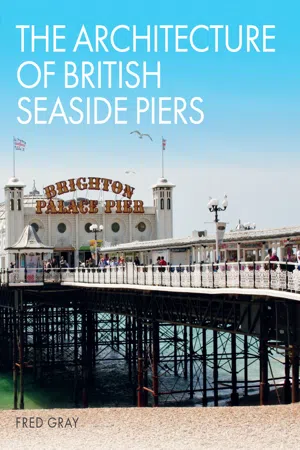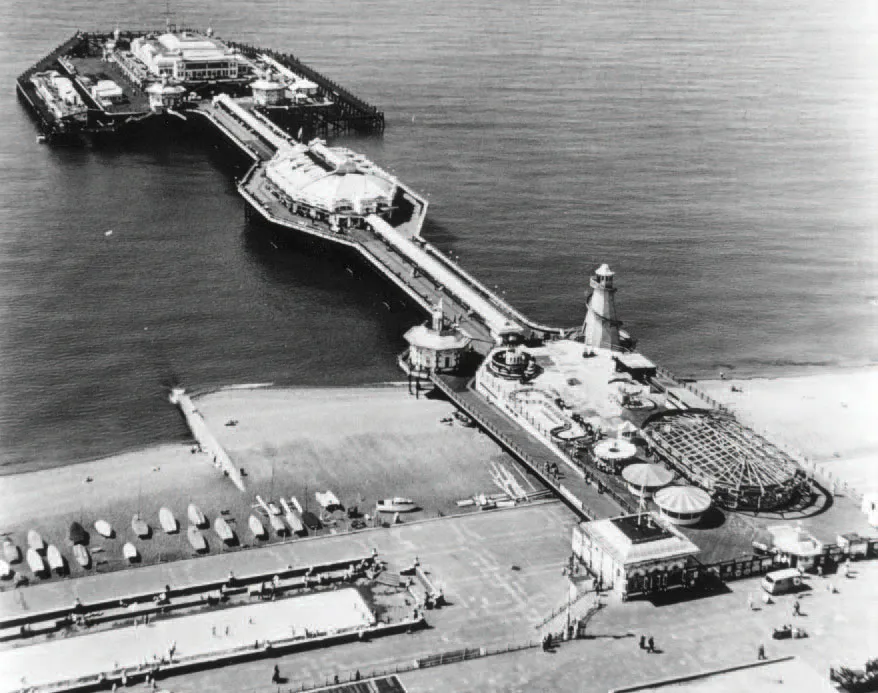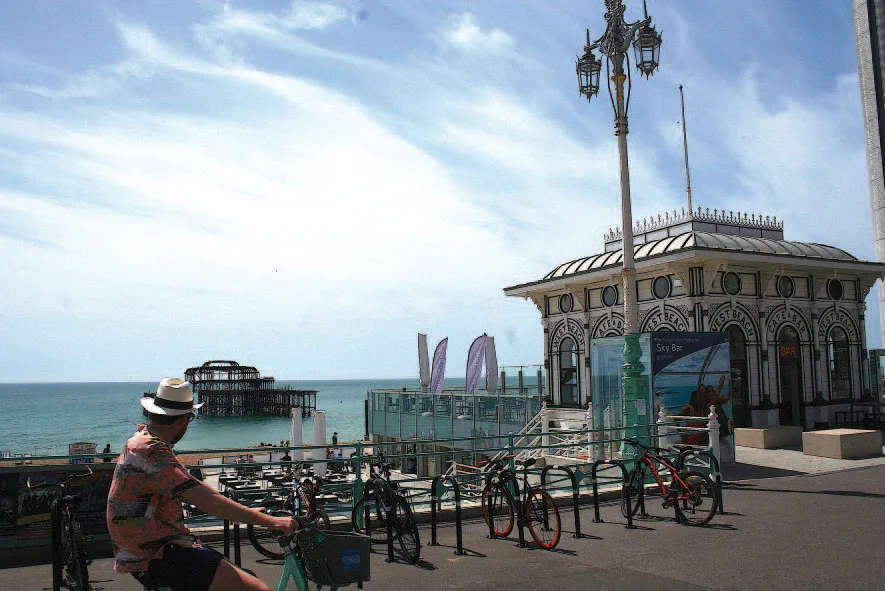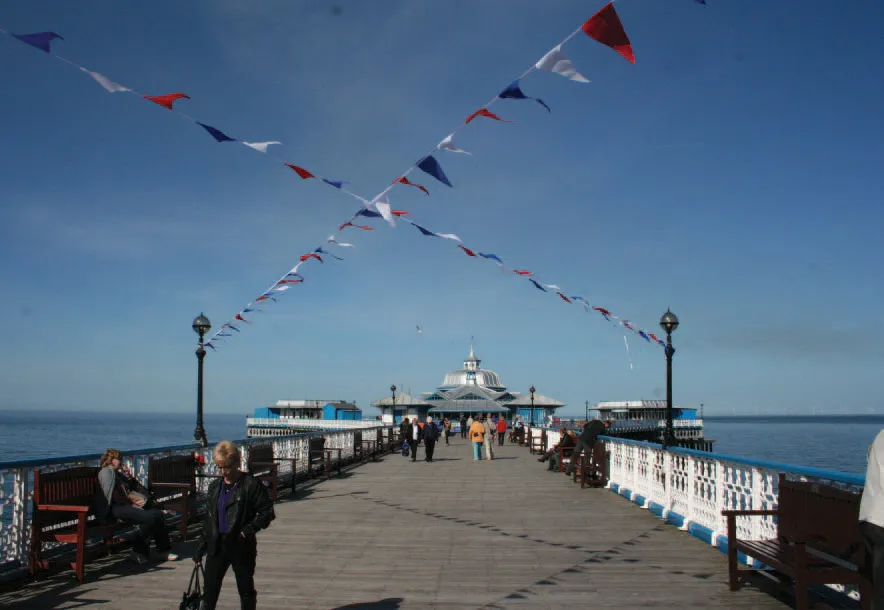![]()
Chapter One
WALKING ON WATER: INTRODUCING BRITISH SEASIDE PIERS
BEGINNINGS
Of all the architectural delights of the British seaside, the most astonishing and idiosyncratic is the seaside pier. Often providing a remarkable visual spectacle, piers also represent an extraordinary architectural and engineering feat.
Piers are rooted on dry land but then take an intrepid journey across the seashore and out over the sea. The architecture and engineering of piers is often extreme and often outrageous. The hostile and marginal coastal zone presents unique challenges of making a structure that is safe, secure and sustainable. But piers also need to lure visitors to venture on a journey over the sea and away from land-based entertainments. The architectural challenge has been to make piers ‘must see’ and ‘must experience’ attractions.
Dreams of pleasure, past and present. The Palace Pier and West Pier, Brighton, April 2011. (Fred Gray)
The essential foundations of all piers are piles, fixed into the shore and seabed, designed to provide security and support for the structure above. The piles are part of the substructure, of columns and arches, ties and braces, girders and associated lattice work, functioning to carry a pier’s superstructure safely above the many perils of the sea below. In turn, superstructures range from simple open decks with protective pier-edge railings to the grand pavilions, huge entertainment halls and associated paraphernalia of pleasure and amusement piers.
The experience of strolling on a piled seaside pier is unlike walking along a harbour arm or promenade wall. While waves glide around a pier’s piles and columns and seawater flows beneath its decks – at least, that is the intention of pier designers – the sea smacks or smashes against hard barriers.
What is nowadays often acknowledged as the first seaside pier, at Ryde on the Isle of Wight, was, according to Simon H. Adamson, technically the first major piled passenger pier.1 Early piers did indeed function as landing stages and select promenades, perhaps with a stand or shelter for musicians to entertain promenaders, but with few architectural embellishments. Today, the grandest of British seaside piers are architectural and engineering confections designed for leisure and pleasure over the sea.
Piers are moveable feasts, their architecture and engineering evolving and changing over time in response to the challenges of nature and the demands of society. Although designed for permanency, piers have often been the most precarious and transitional of built structures. Each pier developed its own particular life history, reflecting local and regional circumstances and events, as well as broader national and international changes in seaside holidaymaking and architecture. We can trace how piers begin, develop, are sometimes transformed or renewed, but on other occasions are ruined and, literally, disappear. In the latter circumstances, construction is eventually followed by deconstruction. Some piers started short but finished long. Others started long but ended up short.
The life history of the Brighton West Pier
The promenade pier shortly after opening, c.1870s. (Brighton West Pier Trust)
The fully-fledged pleasure pier with pier-head theatre and concert hall, c.1920s. (Brighton West Pier Trust)
The pier in transition: the miniature race track was installed in 1927. (Brighton West Pier Trust)
The closed and ruined pier, 1997. (Fred Gray)
The Funfair Pier, c.1950s. (Brighton West Pier Trust)
Metamorphosis: the West Pier in August 2019 with pierhead skeleton and a replica 1866 toll house, part of the i360 observation tower complex. (Fred Gray)
The West Pier as skeleton, 2006. (Fred Gray)
Although there are many variations and exceptions, it is possible to distinguish three overall varieties of seaside pier: first, the earliest and simplest promenade pier; second, the entertaining pleasure pier emerging more than a century and a half ago; and, finally, the amusement and funfair pier of the twentieth century and today. While some of the earliest promenade piers have remained just that – and are nowadays cherished as a civic asset – others have been transformed, in stages, into pleasure piers and subsequently into amusement piers. As to the number of seaside piers, while it depends on the particular definition used, approximately 60 piers survive from around 100 that were constructed in the nineteenth and early twentieth centuries.2
As cultural artefacts, piers may be seen as a material product of the evolving relationship between society and nature on the coast. These artificial structures above the sea enable the seaside to be experienced in a more intense manner than simply being on the shore or a seafront promenade. The senses – including touch and feel, sound, taste and smell – are all assailed more vividly away from the land. Piers transport people to other environments and, at their most powerful, may suggest other worlds, places and times.
The architecture of pleasure: Llandudno Pier in early May 2013. (Fred Gray)
Llandudno Pier in early May 2013. The pier-head pavilion was built in 1905. (Fred Gray)
Llandudno Pier was constructed in the mid 1870s. It was remarkably vibrant in early May 2013. (Fred Gray)
The seaside pier and its architecture are also full of symbolism, about the relationship between society and nature, and of the past, present and future. These varied meanings are reflected in how piers have been represented in the art and literature of the coast. The popular significance of piers is indicated by the huge variety of Victorian and Edwardian seaside souvenirs carrying images of the structures and the deluge of pier postcards sent to family and friends by twentieth-century holidaymakers. Piers became an important and often essential feature of many English and Welsh seaside resorts (there were very few in Scotland). At times the architecture of piers is used to characterize seaside resorts and society or nature more generally. The Victorians viewed their new piers as modern, enterprising and forward-looking. Since the 1960s, images of decayed or destroyed piers have often been used to represent the decline of coastal resorts or society’s ills more generally.
Themes and structure
This book is about the architecture of British seaside piers. Architecture is defined broadly, to include many aspects of design from the style of pier buildings to both engineering and interior design and decoration. It is also about the design process and how the use, purpose and very idea of piers have evolved over time and from place to place. No attempt is made to list and describe each of the seaside piers that have graced British seaside resorts. Instead, drawing on examples, the emphasis is on the ideas, issues and themes that explain the emergence of seaside piers, the rich diversity of their development and the varied processes of change over time.
The remainder of this introductory chapter places piers in the broader context of the development of the British seaside, coastal resorts and seaside architecture. One focus is on piers as an architectural expression of the evolving relationships between society and nature at the seaside. The chapter concludes with a brief look at the export of the idea of piers to other Western countries.
Chapter 2 turns to key themes in the making of piers. It centres, in particular, on the construction of piers during the crescendo of building taking place in the period from 1860 to 1910. One focus is on the key groups of people involved in the making of piers and another on materials and techniques.
The third chapter explores how, in the late eighteenth and early nineteenth centuries, stone harbour arms and timber jetties, designed for other functional purposes, also appealed as promenades to leisured visitors to the seaside. The chapter traces the development of simple piled landing-stage piers, designed to allow passengers safe and comfortable movement between ship and shore. Such piers quickly adopted a promenade role. The distinctive Chain Pier...











